Stars are like our
Sun, but there are many
variations of them. One thing is true, they all
begin there life by the spark of nuclear fusion at
their cores.
Almost every dot in the night sky that we see are
stars. All of those stars exist within our
Milky Way
Galaxy. Very rarely will a lone star actually exist
in the spaces between
galaxies, it is the norm for
stars to only exist within
galaxies.
There are two main groups of stars:
- Population II Stars - old, metal poor stars
- Population I stars - new, metal rich stars
In addition, there are two main endings of a
stars life:
Lifetime of a
normal star:
- Dust cloud forms a Main Sequence star that
burns for about 10 billion years
- Star ends Main Sequence life and swells to a
Red Giant (about the size of
Earth's orbit) and
burns for 100 million years
- Star sheds is layers as a Planetary Nebula
lasting 100,000 years
- Only the core of the star remains as a White
Dwarf
Lifetime of a
large star:
- Dust cloud forms a large star that burns on
the Main Sequence for 50 million years
- Star ends its Main Sequence life by swelling
to a Red Supergiant (about the size of
Mars'
orbit) and burns for a million years
- Core collapse can occur anytime after the
million year Red Supergiant phase, and can go
supernova
- All that is left is a supernova remnant (a
wispy looking nebula) and a compact object -
Neutron Star or
Black Hole
Stars can be classified as living in groups as
there are no "stray" stars existing in the Universe. There are actually three types of stellar
populations:
Open clusters reside mostly within the disk of a
galaxy while
globular clusters exist outside the
galaxy filling a space called the halo. This
halo is actually part of the galaxy and it surrounds
the entire
galaxy.
Open clusters and
globular clusters will be
discussed in greater detail in their own sections.
Of course, a star does not have to be in an
open
or
globular cluster but almost always a star will be
a part of a
galaxy.
Back to Top
But how does the life of a star
begin?
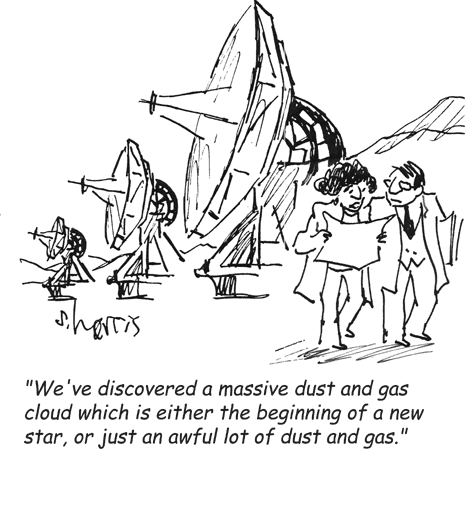
(Science
Cartoons Plus) The most abundant material in the
Universe
is Hydrogen. Clumped together in cold clouds,
hydrogen atoms can join together to form molecular
hydrogen. This only occurs at extremely low
temperatures.
 |
These molecular clouds are very
difficult to detect because no emission
occurs. Much of the interstellar reddening
(where a star or
galaxy appears more red)
occurs because of these molecular clouds.
The image on the left is Barnard 68, a dark
nebula. This is what a molecular cloud
"looks" like. Notice the stars are barely
visible behind this cloud. However, it is
possible to view what's behind the cloud
using an infrared
filter. |
A cloud has to be "just right" before it can host
a future star system. For successful
gravitational
collapse of a cloud to form a proto-star (a star
that has not yet initiated fusion), two criteria
must be met:
These two criteria, discovered by James Jean
in the 1940's, places restrictions on a
collapsing cloud:
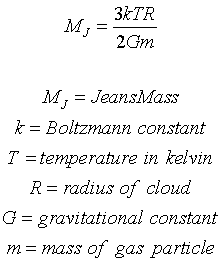
Jeans length basically states
that a molecular cloud of a particular size can
become unstable and begin collapse.

The Radius in the above equation
is Jeans Length, the minimum radius of the cloud
before self-gravitation occurs.
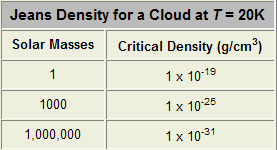 |
The table on the left give some
examples of the density of molecular
clouds and the resulting size of the
cloud. Within a molecular cloud, the
distribution of debris is not always
even. Fragmentation is suspected to
occur in clouds exceeding |
100 Solar masses. Smaller clouds within the
large cloud can form stars. These molecular
cloud fragments also fall under the Jeans
criteria, and does affect the overall molecular
clouds ability to continue self-gravitation, but
that is an advanced topic.
So what can cause a molecular cloud to
collapse?
- Nearby stars that have ended their live
in a
supernova can send a shockwave
stimulating collapse
-
Density waves within a
galaxy propagate
through the spiral structures that can
stimulate collapse
-
Galaxy collisions can create huge
gravitational forces to act of nearby clouds
- A nearby Wolf-Rayet star can stimulate
collapse
- Sequential stellar formation - nearby
stars forming close enough that their
initial fusion can stimulate collapse
The cloud is collapsing, so now what?
| As the molecular contracts under its
own gravity, conservation of momentum
forces the cloud to take on a disk
shape, and it begins to spin. The very
center of the cloud remains circular
while the outlying gas forms a disk.
Material from this disk is ejected
perpendicular to to the disk as seen on
the right. |
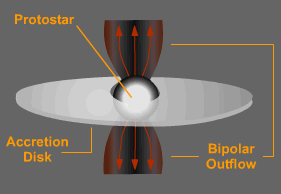
(Image credit: Brooks/Cole Thomson Learning) |
Once the proto-star reaches a certain
temperature, the fusion of hydrogen atoms
begins. The magic
temperature is 10,000,000
Kelvin for our
Sun, but for proto-stars of
varying densities, the following formula
applies:

It is important to know that
there is a limit to stellar formation. The
proto-star must fall within a:
A proto-star that is less than
0.8 Solar masses becomes a Brown Dwarf and a
proto-star that exceeds 100 Solar masses becomes
a Wolf-Rayet star - a very unstable star that
cannot hold on to its outer layers.
As the Hydrogen
atoms at the
core of the proto-star are forced together by
heat and pressure, the Coulomb Barrier is
reached.
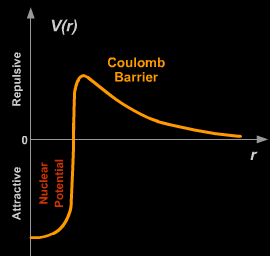
(Image credit: Brooks/Cole Thomson Learning)
The above image demonstrates
that as the radius, r, or the space between
protons is limited, a
strong attractive force
occurs.
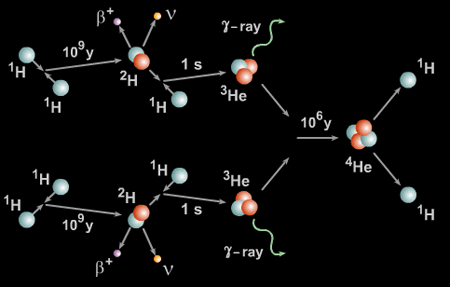
(Image credit: Brooks/Cole Thomson Learning)
The Proton-Proton Chain begins
with the fusing of hydrogen
atoms into helium
atoms - plus some gamma rays,
neutrinos and
photons.
Notice the times in the image
above. It can take 1,000,000,000 years for the
hydrogen
atoms to exceed the Coulomb Barrier.
So what is the equation that
demonstrates the energy produced by this
reaction?

A T-Tauri star is a proto-star
that has begun its fusion burning stage - with a
bang and a shock wave that blows away any nearby
debris close to the star.
I know this may seem like an
overwhelming amount of information for an
introduction, almost as complicated as trying to learn and understand the new system of POS software that came with the online store if there hadn't been some assistance available in learning the software along the way, but these pages are meant to aid you along as well. The following pages will revisit some of this material providing some insight with some real-world examples.
Stellar Astrophysics - the study
of the stellar process - is not an easy subject,
but hopefully this information will bring you
one step closer to fully understanding the
processes of not only our
Sun, but all of the
stars in the
night sky.
Back to Top |

